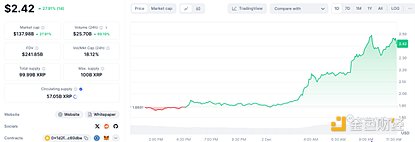
Author: Revc, Golden Finance
Ripple’s native token XRP has once again attracted the attention of the global crypto market. The price of XRP has risen rapidly recently, reaching US$2.42 per coin, and its market value has exceeded US$137 billion, making it the third largest crypto asset in the world by market value. This wave of gains is no accident, but the result of a combination of forces, including favorable market conditions, technological innovation and the continued development of the global encryption field.
Three major driving forces for price surge1. ETF investment plan and new product layout
Ripple recently announced Investing in the rebranded Bitwise Physical XRP ETP is an important step towards mainstreaming crypto assets. The launch of the ETF provides institutional investors with a safe and convenient way to invest in XRP, helping to drive more traditional funds into the crypto market.
In addition, Ripple announced that it will launch the first tokenized money market fund on XRP Ledger and plans to launch RLUSD, a stablecoin pegged to the US dollar. The addition of stablecoins will expand XRP’s practical application scenarios and further enhance the market’s trust in its technology and ecosystem.
2. A clearer regulatory environment
Ripple’s protracted legal dispute with the U.S. Securities and Exchange Commission (SEC) may usher in a breakthrough. SEC Chairman Gary Gensler announced that he would step down in early 2025, and the potential crypto-friendliness of the new US administration further boosted market confidence. Additionally, the New York Department of Financial Services is close to approving Ripple’s RLUSD stablecoin, marking an important step forward in Ripple’s compliance development.
3. Active transactions of whale accounts
Data show that large accounts holding 1 million to 10 million XRP have increased significantly in recent transactions. The activity from these whale accounts drives market momentum and also shows that institutional investors are optimistic about XRP’s future potential. At the same time, the performance of mainstream crypto assets such as Bitcoin and Ethereum has strengthened the overall sentiment of the market, further solidifying XRP’s upward trend.
Short-term risk signal: A warning about the MVRV ratioXRP’s market cap to real value (MVRV) ratio recently surged to 217%, indicating that the market may be at risk of short-term overvaluation. MVRV is an important indicator of market overheating, with an elevated ratio often signaling the possibility of profit-taking and a price correction. However, this correction does not necessarily weaken XRP’s long-term value, but rather provides a more stable foundation for its subsequent price growth.
Ripple’s technology and governance analysis1. Efficient technical architecture
Ripple's payment network RippleNet relies on XRP Ledger to provide an efficient and low-cost solution for cross-border payments. Its technical features include:
-Ripple Protocol Consensus Algorithm (RPCA): avoids the high energy consumption of Proof of Work (PoW) and Proof of Stake (PoS), and relies on the voting of verification nodes to reach consensus.
-High throughput and low fees: XRP Ledger can handle 1500 transactions per second, and the fee per transaction is only 0.00001 XRP, which is much lower than Bitcoin and Ethereum.
2. Centralized governance model
Despite Ripple's technical excellence, its governance model has long been controversial about "centralization":
- Centralization of node distribution: Ripple Labs directly or indirectly controls about 20% of the verification nodes and has great influence on the selection of the Unique Node List (UNL).
- XRP supply centralization: Ripple Labs holds more than 50% of XRP and unlocks it regularly through an escrow mechanism, which is enhanced by this distribution mechanism It improves its ability to control market supply and demand, but also weakens the credibility of decentralization.
Future Challenges1. Difficulties of Globalization and Regulatory Compliance
Although the regulatory environment in the U.S. market may improve, Complexity in other regions remains an obstacle to Ripple's globalization. Especially in the context of the implementation of the European MiCA regulatory framework, Ripple needs to increase compliance investment to ensure the legality of its products on a global scale.
2. Technological innovation and competitive pressure
Ethereum’s payment channels and DeFi applications are gradually expanding their market share, which poses a challenge to XRP’s competitive position. Ripple needs to continue to advance technological iterations to maintain its core advantage in efficient payments.
3. Market volatility and selling pressure risk
The 1 billion XRP that Ripple is about to unlock may have a short-term impact on the market. In addition, high whale holdings can exacerbate price volatility when market sentiment is unstable.
SummaryRipple and XRP are at a critical stage of rapid development. From ETF investment, the launch of stablecoins, to the continued expansion of cross-border payment networks, Ripple has demonstrated a strong driving force in the mainstreaming of crypto assets and technology applications. However, its centralized governance model and token distribution mechanism are still important factors that restrict its recognition by a wider range of users. Compared with community-driven networks such as Ethereum, RippleThe governance appears to be more "corporatized". While its governance process includes feedback from community nodes, Ripple Labs’ voice dominates. This "top-down" approach to governance may be contrary to the idea of a decentralized community.
Ripple’s future success will depend on its ability to respond nimbly to global regulatory trends, as well as efforts to further decentralize network governance and token holdings. XRP Ledger's technical advantages in the payment field give it the opportunity to become the standard for enterprise-level payments. This "function first" approach may attract user groups that do not have decentralization as their first priority. If Ripple can balance the needs of decentralization with enterprise applications, its long-term potential will continue to be recognized by the market.
In addition, investors can also pay attention to crypto projects and listed companies affected by the new U.S. With the loosening of the regulatory environment, the improvement of institutional recognition, and the launch of a new round of investment layout, these companies and projects are expected to usher in good growth performance.












